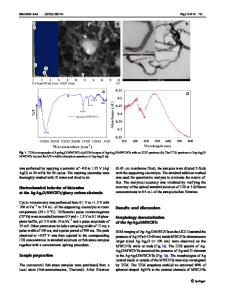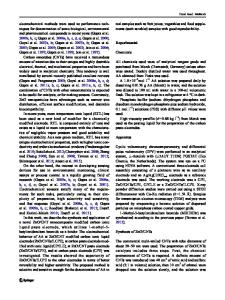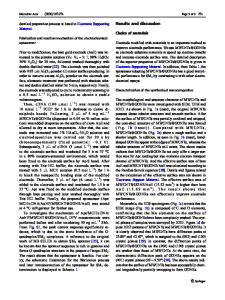A reliable electrochemical sensor for detection of catechol and hydroquinone at MgO/GO modified carbon paste electrode
- PDF / 3,439,002 Bytes
- 13 Pages / 595.276 x 790.866 pts Page_size
- 15 Downloads / 375 Views
A reliable electrochemical sensor for detection of catechol and hydroquinone at MgO/GO modified carbon paste electrode K. Chetankumar1, B. E. Kumara Swamy1,*
, and T. S. Sunil Kumar Naik2
1
Department of P.G Studies and Research in Industrial Chemistry, Kuvempu University, Jnana Sahyadri, Shankaraghatta, Shivamogga, Karnataka 577451, India 2 Department of Materials Engineering, Indian Institute of Science, Bangalore 560012, India
Received: 7 July 2020
ABSTRACT
Accepted: 14 September 2020
Herein, report a reliable, potent and more sensitive electrochemical sensor for the selective investigation of hydroquinone (HQ) and catechol (CC) at magnesium oxide and graphene oxide modified carbon paste electrode (MgO/GO/ MCPE). The prepared MgO nanoparticle was confirmed by X-ray diffraction (XRD) and scanning electron microscopy with energy dispersive X-ray (SEM– EDX). The constructed electrode provides high current reaction with low detection limit for CC (0.45 lM) and HQ (0.37 lM). The effect of pH, sweep rate, concentration was carried electrochemically. The fabricated MgO/GO/MCPE depicts electrode process was adsorption controlled and gave fine electrocatalytic activity towards simultaneous electrochemical analysis of CC and HQ. The MgO/GO/MCPE exhibits excellent stability with fine selectivity and sensitivity. The analytical testing of modified electrode has been analysed in tap water sample as real sample with acceptable recovery.
Ó
Springer Science+Business
Media, LLC, part of Springer Nature 2020
1 Introduction At present, nanomaterials were used in numerous applications of science and technology due to the special nature of these materials [1, 2]. Nanoparticles (NPs) like metal oxide are owing to great physical and catalytic properties and they were employed in electrochemistry to improved their electrocatalytic performance e [3–5]. The NPs modified electrode improved the signal response, sensitivity and better reproducibility [6–8] and they have a broad range
Address correspondence to E-mail: [email protected]
https://doi.org/10.1007/s10854-020-04498-x
of bioscience applications. In recent years, MgO nanoparticles are popular in bio-electrochemical and electrochemical operation to ease the electron transfer in different types of sensors [9, 10] and upgrade the electrode surface in batteries [11] due to their ability to facilitate electron transmission. The MgO nanoparticles can be applied in electronics, coatings, ceramics, catalysis, petrochemical products and many other fields. Graphene oxide (GO) was [12] also have identical properties such as remarkable electrical conductivity, more oxygen-containing functional
J Mater Sci: Mater Electron
groups, good water solubility, large surface area and it shows higher platform for the better performance of electrochemical sensors [13, 14]. Though the bare GO is limited for the analysis of CC and HQ because of its lower electrocatalytic performance than metal based GO composites. The combining of GO and metal oxide nanoparticle were obtaining a high s
Data Loading...











